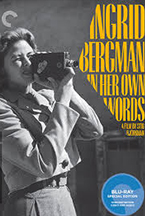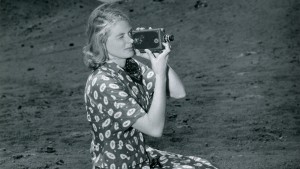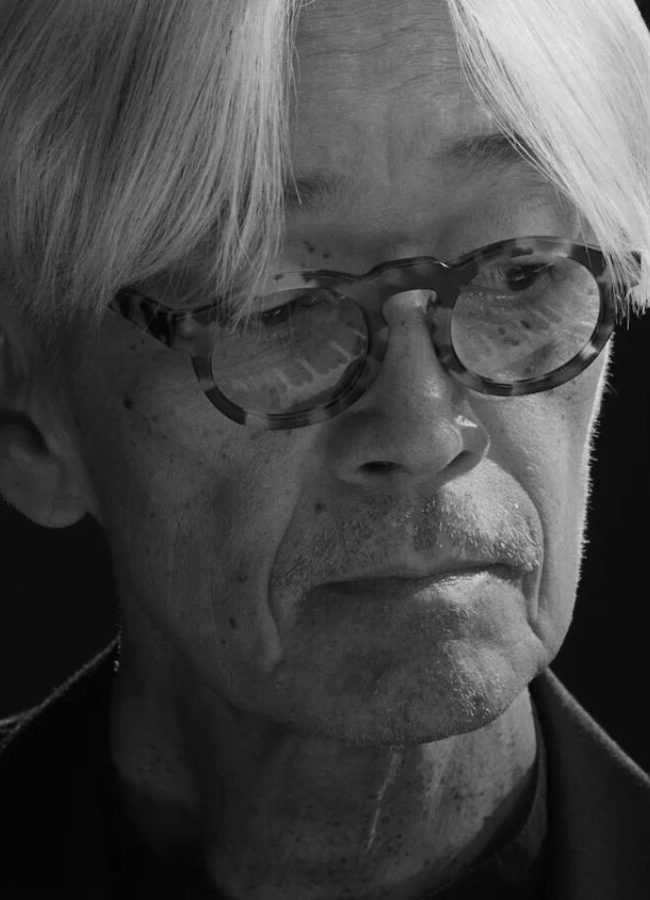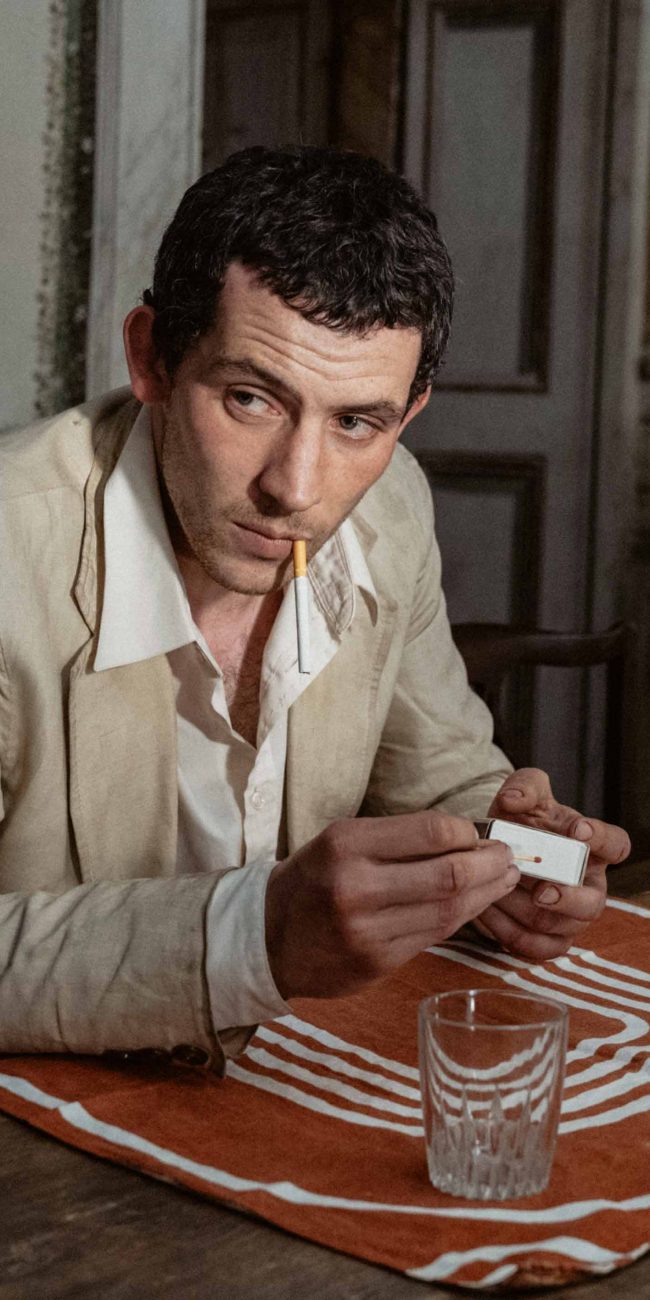THE CURBSIDE CRITERION: INGRID BERGMAN: IN HER OWN WORDS

(We here at Hammer to Nail are all about true independent cinema. But we also have to tip our hat to the great films of yesteryear that continue to inspire filmmakers and cinephiles alike. This week, our “The Curbside Criterion” continues where HtN staff can trot out thoughts on the finest films ever made. Today Christopher Llewellyn Reed takes an in-depth look at the new Criterion Blu-Ray release of Ingrid Bergman: In Her Own Words. Bergman would’ve been 100 years old this week.)
The great Swedish actress Ingrid Bergman (1915-1982), whose life was cut short, after a long battle with breast cancer, at the still-young age of 67, left behind a rich legacy of work on stage and screen, with notable examples of the latter including Casablanca, Notorious, Journey to Italy and Autumn Sonata, to name but four. She won three Academy Awards – Best Actress in Gaslight, Best Actress in Anastasia, and Best Supporting Actress in Murder on the Orient Express – a record matched, as of this writing, only by Meryl Streep and surpassed only by Katharine Hepburn. Her career spanned six decades, making her one of the superlative and defining movie stars of the 20th century. She survived a scandalous – because adulterous! – love affair with Italian director Roberto Rossellini, in the middle of which she was actually denounced on the floor of the U.S. Senate for her evil ways, eventually returning to the United States with her head held high, unfazed by the moral self-righteousness of those who had no business to judge.
Out of that initially “illicit” union (eventually made proper through marriage), came three children, one of whom is the model-turned-actress Isabella Rossellini (she had a previous daughter with her first husband). And it is that daughter, according to director Stig Björkman (…But Film is My Mistress) in an interview that is part of this new Criterion Collection Blu-ray release, who had the idea for a documentary about her beloved mother, made in 2015 and now available for any and all who may have missed it in its limited theatrical run. If you haven’t already seen it (and you have, watch it again!), Ingrid Bergman: In Her Own Words is a magnificent tribute to a woman whose luminous presence graced many an exceptional movie (or raised the quality of the occasionally more pedestrian fare in which she also starred). Fiercely independent and devoted to her craft, Bergman was also an obsessive chronicler of her own life, documenting its progression not only through letters and diaries, but also on 8mm and 16mm film. Preserved in the Ingrid Bergman Collection at Wesleyan University and in the home archive of Pia Lindström (Bergman’s first child), these home movies form the delightful visual backbone of Björkman’s lovely cinematic paean to one of the greatest actress of the twentieth century.
Present-day Swedish actress Alicia Vikander (Ex Machina) – herself the latest Scandinavian export to make an award-winning landing on our shores – reads selections, in Swedish, from Bergman’s writings, while we hear Bergman, herself, in some of the many interviews she conducted in (mostly) English, French and Swedish. Bergman’s four children are principal interview subjects, and from their clear love for their mother, we get a true sense of what she must have been like. Pia, who was almost a teenager when Bergman effectively abandoned her for Rossellini (at least until Pia turned 18 and could travel freely on her own), has nothing worse to blame her mother for than that she wishes she had had more of her. We can see the joy that Bergman spread around her, both in those home movies and in the elegiac (though not uncritical) recollections of her progeny. Actresses Sigourney Weaver (Alien) and Liv Ullmann (Cries & Whispers), each of whom had the opportunity to work with Bergman – the former at a critical early juncture of her own career – also show up to discuss what made Bergman special to them. Beyond the lovefest, Björkman’s documentary is also a wonderful chronicle of the evolution of culture and cinema over the course of Bergman’s life. It is a film to be cherished and savored, much as we should also cherish and savor Bergman, herself.
Presented in high-definition with its archival materials scanned in either 4K or 2K resolution, with a 5.1 surround-sound mix, the video and audio quality of the Blu-ray disc are what we have come to expect from Criterion. As is standard for the company, there are quite a few special features included, most of which bring fascinating additional information to the package. There’s a written essay by noted film scholar Jeanine Basinger, longtime Chair of Film Studies at Wesleyan University and curator of that institution’s cinema archive; an interview with director Stig Björkman; seven minutes of uncut home-movie footage from Pia Lindström’s collection; two deleted scenes; two extended scenes; excerpts from two Swedish films made at the start of Bergman’s career; the music video of the end-credit song; and the movie’s trailer. What follows is my review of all of these ancillary materials.
Jeanine Basinger essay, “A Full Picture of a Life”
Jeanine Basinger is a scholar of great accomplishment, and someone whose work I generally admire, yet this particular essay is, sadly, not one of her stronger efforts, particularly when compared to the accompanying essays in most other Criterion releases (such as Night and Fog and Clouds of Sils Maria, both of which I recently reviewed). Whereas the best of these provide a detailed overview of the production history of the film, Basinger’s is more of a laudatory introduction, filled with praise for the work within, but lacking in illuminating specifics. It’s more in line with the kind of preface one sees in academic texts when a noted specialist is asked to give his or her blessing to what follows. Basinger deserves enormous credit for overseeing the preservation of many of the home movies and letters that have found their way into Björkman’s film, but her “A Full Picture of a Life” offers slim, if any, analysis of the movie, itself.
Interview with director Stig Björkman (18:34min)
Fortunately, director Björkman’s interview more than makes up for what is missing in Basinger’s piece. Offering up informative anecdotes about both the inspiration for, and production of, the movie, Björkman takes us on a journey from start to finish that answers many of the questions raised by the documentary. We learn how Isabella Rossellini approached him about making the film; how Alicia Vikander became involved; how he arrived at his particular approach to the story, after first considering others; and how he chose to shoot additional 8mm and 16mm footage, of Bergman’s children and other interviewees, to mix in with the archival material. Interestingly, that additional film was shot by Swedish singer Eva Dahlgren, whose song “The Movie About Us” plays over the end credits. All in all, a great feature.
7 minutes of home movie footage from Pia (7:07)
While not more interesting than what is included in the documentary, itself (and some of this footage is, in fact, in the movie), this reel nevertheless allows an additional glimpse into the life of the young Ingrid Bergman in the days and months after the birth of her first child, Pia Lindström, in 1938.
Deleted Scenes – 2 of them
There are two scenes included here, both of which add to our understanding of Bergman:
- “How I would raise my daughter” (2:54min) – An essay, from Dec. 5, 1932 (when Ingrid Bergman was 17), read by Bergman’s three daughters: Pia Lindström and fraternal twins Isabella and Ingrid Rossellini. It’s a very sweet sequence, in which Björkman cuts between each sister as they read different parts of the essay, sometimes laughing, sometimes moved.
- Rosario Tronnolone, “film historian and owner of the world’s largest private collection of Bergman materials.” (8:45min). It’s clear why this was cut, since Tronnolone doesn’t necessarily add anything that isn’t covered elsewhere in the documentary, although his contribution is fairly entertaining. He starts at the church where Bergman married Rossellini and then brings us into his apartment where he shows us his favorite photographs of the star. He is actually quite perceptive on Bergman’s inner qualities as both a human being and actress.
Extended Scenes – 2 of them
There are two extended versions of scenes already in the documentary:
- Shubert Theater scene – conversation with Sigourney Weaver, Isabelle Rossellini and Liv Ullmann (14min). All three women provide additional details on their relationship with Bergman. Weaver recounts a delightful incident where famed costume designer Edith Head, along with Alfred Hitchcock and others, all came to see the Los Angeles production of a play in which Bergman was starring. Ullmann talks about life on the set of Autumn Sonata. Rossellini acts as a sort of discussion leader, eventually leading all three of them to discuss the challenges of aging in Hollywood. It’s a great addition.
- Rossellini siblings interview (5:48min) – this extended conversation with all three Rossellini children is less illuminating, but not without its charm. Both Ingrid and Isabella express how much they wish they had had more time with Bergman as adults. It’s quite sad, actually, to hear them talk about how much they miss their mother.
Landskamp – from 1932 – first screen appearance of Ingrid (34 seconds)
This clip is actually in the documentary, and unlike its placement there, here there is no explanation of where to find Bergman in the shot (hint, she’s at the very end of the line). Still, for purely historical purposes, it’s nice to have this included.
On the Sunny Side – from 1936 – outtakes (4:02min)
Even in 1936, at the tender age of 21, Bergman shines in these outtakes. It’s clear why producer David Selznick would invite her to America after seeing her in the Swedish version of Intermezzo (which he remade, with Bergman again, in 1939, launching her Hollywood career).
Music video for Eva Dahlgren’s end-credit song, “The Movie About Us” (4:42min)
I found Dahlgren’s song a little jarring at the end of the documentary, upon first hearing it, since it sounds so contemporary to our own time, but watching the video, with the same kinds of home-video footage used in Björkman’s feature (which is why he asked Dahlgren to shoot the 8mm/16mm stuff for him), I gained a new appreciation for the music. It still doesn’t quite work in the end credits, for me, but the music video is beautiful, on its own.
Trailer (1:35)
It’s a trailer, and a pretty good one, too.
Overall, then, I recommend both the documentary and the Blu-ray in the most glowing terms. It’s perfect for lovers of film history and Ingrid Bergman, alike.
– Christopher Llewellyn Reed (@ChrisReedFilm)













